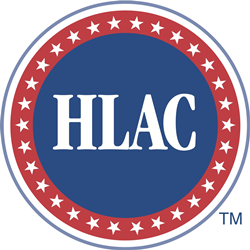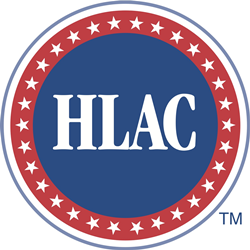
The Healthcare Laundry Accreditation Council is marking its 15th year in 2021.
“We’ve seen progressively greater interest in our standards and this includes increasing attention from a broader professional audience beyond operators of healthcare laundries.” – Linda McCurdy, HLAC Board President
PLAINFIELD, Ill. (PRWEB)
January 27, 2021
The Healthcare Laundry Accreditation Council (HLAC) is marking its 15th year in 2021 as the leading nonprofit organization that inspects and accredits laundries that process reusable textiles for hospitals, nursing homes, and other healthcare facilities – based on the highest, professionally recognized standards for patient safety and infection prevention.
HLAC, incorporated in 2005, began actively inspecting and accrediting laundries in 2006 in response to years of requests from textile professionals for an independent accrediting body that would create a program of accreditation acknowledging that a laundry organization meets the highest standards for processing textiles.
“We’ve always enjoyed steady growth each year in the number of healthcare laundries wanting to achieve HLAC accreditation,” said Linda McCurdy, HLAC board president. “But this past year has been a busy one, especially with the coronavirus pandemic. We’ve seen progressively greater interest in our standards and this includes increasing attention from a broader professional audience beyond operators of healthcare laundries. From infection prevention (IP) managers in hospitals and senior-living communities, to those in charge of hygiene in schools, hospitality lodging and even correctional facilities, IP professionals are beginning to realize that HLAC standards can provide viable safeguards in their efforts to tackle pandemic challenges and beyond.”
Standards Based on Federal Regulation, Best Industry Practices
HLAC inspected and accredited laundries process healthcare textiles (HCTs) based on the highest standards for patient safety and infection prevention. These HLAC Accreditation Standards have been developed based on federal regulations and guidelines as well as best industry practices.
“Being familiar with our standards makes all the difference for a laundry because it enables it to keep pace with the growing complexities of processing healthcare linens,” McCurdy said.
The standards are established as the minimum acceptable practice for the preparation of hygienically clean, reusable healthcare textiles for patient care, implemented and executed by accredited laundry facilities processing reusable healthcare textiles. The HLAC Accreditation Standards document, “Accreditation Standards for Processing Reusable Textiles for Use in Healthcare Facilities,” covers the complete textile processing cycle and pays special attention to laundry processes directly related to patient safety and OSHA-required practices, including Bloodborne Pathogen Exposure Control Standards.
Both the 73-page standards document and a 34-page standards checklist are available for free in downloadable PDF formats.
What It Means to be Accredited
There are currently more than 160 accredited laundries in the USA and Canada.
HLAC accreditation, which is good for three years, affirms that a laundry organization that processes HCTs has successfully passed inspection of the following: its facility, policies and procedures, training programs, and its relationship with its healthcare customers.
HLAC inspectors are independent contractors selected by HLAC’s board of directors. Inspectors have wide-ranging experience in the industry, including with healthcare systems, in environmental services, laundry production and operations, laundry facility planning and design, linen management, nursing, occupational safety, and infection prevention and control.
Each inspector is provided with in-depth training of HLAC standards and inspection guidelines before they begin their work.
“The inspection is an important part of the accreditation process,” McCurdy said. “Going through the inspection process should help a laundry to unite its efforts to become much stronger – smarter and more competent in processing healthcare textiles – and this should enable them to provide their healthcare customers with an improved level of service ultimately benefitting patient safety.”
HLAC inspections place significant weight on factors such as design, equipment, practices, training, protocols and adherence to regulatory body requirements.
HLAC’s History of Innovation and Responsiveness
From its beginning, HLAC has been at the leading edge of industry innovation:
- In 2011, it added surgical pack assembly room standards to its overall standards document. These new standards are based on the American National Standards Institute (ANSI)/Association for Advancement of Medical Instrumentation (AAMI) reference regarding reusable surgical textiles processing.
- In 2016, HLAC’s standards document was awarded the AHE Seal of Review and Recognition™ from the Association for the Healthcare Environment. The award followed a technical review process by an advisory council of degreed, certified healthcare professionals who are leading authorities in the practice of environmental services and its related disciplines.
- In 2018, to broaden awareness of the issues among IPs, HLAC published a digitized four-part “Infection Control Today” series on healthcare laundry’s role in infection prevention strategy.
- In 2019, HLAC debuted its new HLAC Laundry Process Monitoring ToolKit. Developed by HLAC, the new process monitoring toolkit (PMTK) validates the effectiveness of a laundry’s processes by measuring the number of microorganisms found in a laundry on hard surfaces, in the air, on linen, in the water, and on employee hands.
Likewise, HLAC has been at the forefront in responding to current events affecting the industry with useful information and direction:
- In 2014, in response to reports linking infections to hospital linens, HLAC offered suggestions to hospitals to ensure that textiles remain hygienically clean from processing, distribution and on to patient use and encouraged hospitals to have a policy and procedure dealing with the transportation and storage of clean textiles as well as for addressing the transportation and storage of contaminated textiles.
- Also in 2014, in the wake of Ebola fears, HLAC urged “diligence to the highest standards” in following the safest laundry procedures and directed concerned professionals to guidance from the Centers for Disease Control and Prevention (CDC) as well as its own relevant guidelines offered in its standards document.
- In 2020, as healthcare and public policy officials began grappling with effective strategies to contain the novel coronavirus outbreak, HLAC issued a reminder that established cleaning and disinfection practices had a critical role in reducing environmental transmission and averting a medical crisis.
- Also in 2020, with the coronavirus pandemic taking a toll on senior living facilities, HLAC launched an awareness communications campaign promoting its standards with the message that, upon inspection, HLAC accreditation is available to senior-living facilities that launder on-premise, or for their outsourced laundry.
Pride and Passion
Commenting on the past and future of HLAC, McCurdy reiterated, “There have been many dedicated individuals who have been involved in the advancement of HLAC and its mission, and in the development and evolution of its nationally recognized standards. We can all take great pride in knowing that HLAC today is an important part of the safety solution in healthcare’s ever-urgent effort to protect patients through the prevention of infections.”
She concluded: “HLAC-accredited laundries can tell their clients they share their patient safety goals, that they’ve raised the bar on how a laundry should process healthcare textiles, that their clients can have confidence in the laundry’s highest of standards, and that that their practices are the industry’s best and most current available.”
Share article on social media or email:

